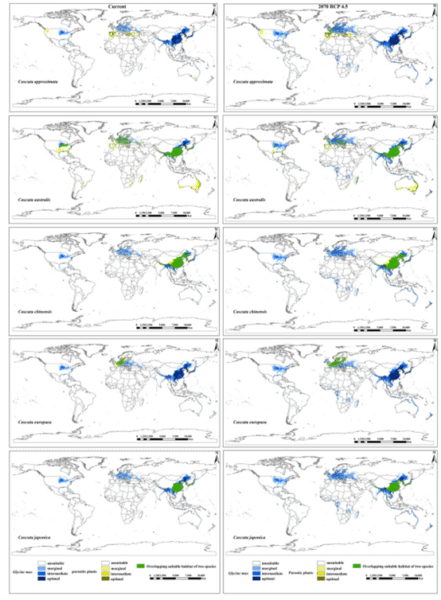Some parasitic plants are major pests in agriculture, but how this might be affected by climate change remains largely unknown. In this study, we assessed this question for five generalist holoparasitic Cuscuta species (smoothseed alfalfa dodder [Cuscuta approximata Bab.], alfalfa dodder [Cuscuta europaea L.], soybean dodder [Cuscuta chinensis C. Wright], Peruvian dodder [Cuscuta australis R. Br.], and Japanese dodder [Cuscuta japonica Choisy]) and two of their main Leguminosae host crop species (soybean [Glycine max (L.) Merr.] and alfalfa [Medicago sativa L.]. For each of the five Cuscuta species and the two crop species, we ran MaxEnt models, using climatic and soil variables to predict their potential current distributions and potential future distributions for 2070. We ran species distribution models for all seven species for multiple climate change scenarios, and tested for changes in the overlap of suitable ranges of each crop with the five parasites. We found that annual mean temperature and isothermality are the main bioclimatic factors determining the suitable habitats of the Cuscuta species and their hosts. For both host species, the marginally to optimally suitable area will increase by 2070 for all four representative concentration pathway scenarios. For most of the Cuscuta species, the marginally to optimally suitable area will also increase. While the suitable areas for both the hosts and the parasites will increase overall, Schoener’s D, indicating the relative overlap in suitable area, will change only marginally. However, the absolute area of potential niche overlap may increase up to 6-fold by 2070. Overall, our results indicate that larger parts of the globe will become suitable for both host species, but that they could also suffer from Cuscuta parasitism in larger parts of their suitable ranges.
Weed Science 70(5):543-552, 2022.
